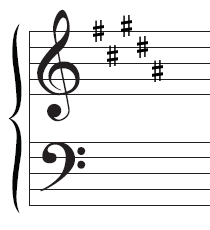As I mentioned last week, time signatures are only one part of the important information given at the beginning of any piece of sheet music. Key signatures are the other part–they tell us what key the music is in, which gives us more information about the pitches used in the song.
First: A Few Notes (Heh) About Sharps and Flats
To learn more about key signatures, you need to know what sharps and flats are. Instead of being slang words for medical needles and shoes (or apartments, lol), respectively, in music these two words take on quite a different meaning.

|
This little “b”-like symbol is a flat. Whenever you see this, it means that you lower the pitch of whatever line it’s on by a half-step. In this case, the flat symbol is on the B line. Instead of playing a regular B, you would play a B-flat instead, one half-step down from regular B (the musical term for “regular B” is B-natural).
|

|
This little hashtag-like symbol is a sharp. This means you raise the pitch of whatever line the sharp is on by a half-step. In this case, the sharp symbol is on the F line. So, instead of playing an F-natural (“regular F,” lol), you would play an F-sharp, one half-step above F-natural.
|
You’ll see these symbols scattered around your music, adorning the left sides of notes as well as dotting the beginning of your sheet music. But their meanings do not change–flats mean lower the pitch, sharps mean raise the pitch.
The Making of a Key Signature: A Collection of Sharps or Flats
At the beginning of your sheet music, you’ll have anywhere from one to seven sharps or flats, all grouped together like this:

|
This is an example of a key signature–it tells you which notes are sharped/flatted in the piece, which tells you what key the music is in. (Musical keys are collections of 8 notes which all “fit together” to make harmonious combinations called “chords.” Each key is different, hence the need for key signatures to signal which one to use.)
|
Making Sense of a Key Signature
Since we know that sharps raise the pitch of whatever line they’re on, while flats lower the pitch, then we can tell which notes are altered for the particular key we’re in.

|
This lone little B-flat, as we learned earlier, is a key signature by itself–the key of F major. F major is kind of the “baseline” key signature for those written in flats–when you see one flat, you know it’s using the F major scale.
|

|
This lone little F-sharp indicates the key of G major–G major is the “baseline” key signature for those written in sharps. One sharp means it’s a G major scale!
|
For key signatures using two flats/sharps or more, there are a couple of little tricks to reading them.
Trick for Reading Flats

|
For flats, the trick is to look at the next-to-last flat in the group of flats, reading from left to right, that make up the key signature–that will tell you which key you’re in. In this case, the next-to-last flat is a B-flat, which means this key signature is for the scale of B-flat major.
|

|
Using the trick we just learned, which key does this key signature represent? Remember, the next-to-last flat matches the key.
|

|
And how about this one? 🙂 (Don’t worry–there’s an answer key at the end of this article :P)
|
Trick for Reading Sharps

|
For sharps, the trick is to look at the last sharp in the group, reading from left to right, and raise the note by one half-step to get the key. For instance, the last sharp in this key signature here is a C-sharp (it’s in the C space), so raise that by one half-step and you get a D. This means that this key signature is using the scale of D major.
|

|
Using this trick, which key is this? The last sharp, raised up a half-step, will tell you!
|

|
And how about this one? 🙂
|
Even Faster Trick: Just Count the Flats or Sharps!
Though it’s best to know your flats and sharps well so that you can recognize them by sight, there’s a little shortcut experienced musicians use to reference various key signatures in short form. Just count the number of flats and sharps, and memorize which key goes with which number of flats or sharps.
For instance, one flat means F major, one sharp means G major; two flats means B-flat major, two sharps means D major, and so on. It really helps when you get up into the five- and six-sharp territories! 🙂
Yay! You Know How to Read Key Signatures!
With a little practice, you’ll be able to recognize key signatures as quickly as the pros do. (It DOES get easier, believe me!)
For Further Reading/Credits
Key Signatures @ Wikipedia
Clefs and Key Signatures @ LearnMusicFree.com
As Promised: The Answer Key!

F major |

B-flat major |

E-flat major |

A-flat major |

D-flat major
(aka C-sharp major) |

G-flat major
(aka F-sharp major) |

C-flat major
(aka B major, lol) |

G major |

D major |

A major |

E major |

B major |

F-sharp major |

C-sharp major
(aka D-flat major) |
|














One thought on “Music Theory Fun, part 4: Decoding the Key Signature”